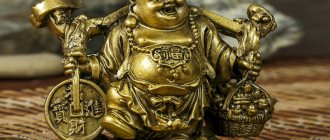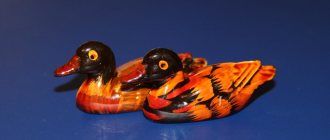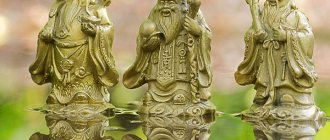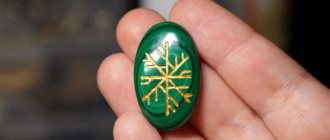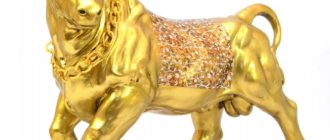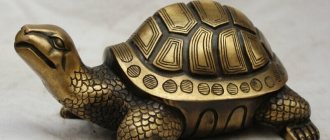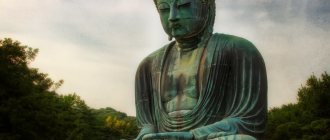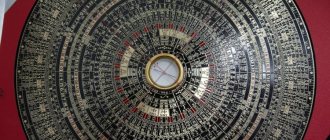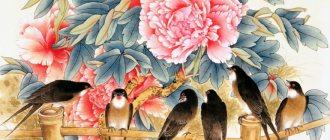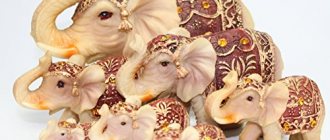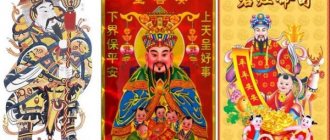Seven gods of happiness in Japan
In Japan, after the New Year holidays, somewhere before mid-January, it is customary to visit temples and pray to one of the favorite gods of the Japanese - the seven gods of happiness (luck) - shichifukujin. These gods originated in Japan, in the ancient city of Kyoto around the 14th century during the Muromachi period, they are not "native" to Japan. The gods came from different countries: China, India, one god Ebisu is Japanese, and from different religious movements such as Shintoism, Taoism, Buddhism and Brahmanism.
The number seven is a sacred number in both China and Japan. Scrolls on which the seven gods were drawn in the 14th century could be found in Kyoto on the walls of teahouses; taking into account the Japanese flavor, the scrolls were decorated and began to gain popularity among the population. The Seven Gods of Fortune are deities who bring good luck, prosperity, wisdom, wealth and longevity. According to legend, they arrived to the shores of Japan on the ship of fortune "Takarabune", on a ship filled with treasures, rice, in addition to material wealth, the ship was filled with wisdom, longevity, health and good luck.
But at first the gods existed separately from each other, and later they were united into a single group of cheerful and cheerful gods. The composition and number of gods in this magnificent seven changed and only in the 17th century this group was formed in the form in which it is presented today. The seven gods represent the seven virtues - longevity, wealth, sincerity, dignity, fame, generosity and friendliness. The seven gods are: Ebisu, Daikoku, Bishchamon (or Tamonten), Benzaiten, Fukurokuju, Hotei and Jurojin.
Three gods - Daikoku, Bishchamon and Benzaiten - were borrowed from India, Hotei, Jurojin and Fukurokuju came from China, the god Ebisu is the only one of the seven gods of Japanese origin. According to the ancient legend, Ebisu is the first-born of the first and main gods of Japan Izanagi and Izanami, he was born without bones for which he was named Hirako - tadpole, shortly before his third birthday he was carried away on a boat to the sea. After long wanderings on the waves, his boat washed up on the shores of the island of Matsumae (now Hokkaido), where he was picked up by the Ain (aboriginals of the island) Ebisu Saburo. Overcoming great difficulties, Hirako grew arms and legs and turned into the god Ebisu.
In Japan, a separate temple was built for each of the seven gods, and these temples are located not far from each other, so that during the pilgrimage period, believers can move from temple to temple and pray to the gods of good luck. As a rule, during the period of mass visiting of temples, there are signs between them, so that even visitors can easily find their way to all the temples of the seven gods, but at this time of year you can’t go wrong if you just follow the crowd that follows in front of you, because Everyone has the same route - the sanctuaries of the deities of luck.
Let's get acquainted with the kind, cheerful and generous deities so revered by the Japanese.
Ebisu is the most beloved god of the lucky seven by the Japanese. He is always depicted wearing a hat, holding a fishing rod in his right hand and a tai fish (sacred fish) in his left. Initially, it was the god of fishermen, then began to be revered by farmers and traders. God Ebisu also takes care of the health of young children and is also believed to ensure safe travel.
The Japanese who need good luck in trading, fishing or farming always try to visit the Ebisu Shrine, pray and buy an amulet. In temples, everyone will be sold a branch of bamboo for 3,000 yen, which symbolizes permanence and stability. Bamboo is a symbol of the god Ebisu; in addition, the temple servants will offer other talismans and decorate a bamboo sprig with them. This bamboo is installed at home and helps its owner in business throughout the year. At the end of the year, the bamboo is taken to the temple and burned there.
Daikoku - the god of wealth and household, particularly in the kitchen, is the patron saint of peasants. He has a flat black hat on his head and a wide smile on his face. He is depicted standing on two bags of rice, with the bag over his shoulder and a wish-granting hammer. With each tap of the hammer, what he wants appears and coins fall, and behind his shoulder in a bag he has wisdom and patience, and perhaps treasures or rice. Daikoku, like Ebisu, is worshiped by farmers and these two gods are often depicted together, as they bring prosperity and wealth.
Bishchamon (or Tamonten) - he is depicted in samurai armor, with a spear in one hand and a small pagoda in the other, symbolizing the divine treasury. He is the patron of warriors, lawyers and doctors, and brings good luck and wealth.
Benzaiten is the only female among the gods of luck and symbolizes wisdom, love, art, eloquence and beauty. The Benzaiten figurine is depicted with a traditional Japanese lute - a biwa; its companions are always a snake and water. Benzaiten is also considered a water deity. There is another image of the deity - a warlike eight-armed goddess holding spears, swords and other weapons in her hands. But the Japanese are closer to the charming and beautiful patroness of everything beautiful, and therefore this particular image has taken root in Japan. And people of art come to Benzaiten Temple to pray and receive inspiration.
Fukurokuju is the god of wisdom, luck and longevity. He is depicted with an outstretched head, accompanied by a black deer; it is believed that if the deer has lived for 2000 years, then it becomes black, or a crane with a turtle. Fukurokuju is the lord of the southern polar star. He is often depicted holding a fan. He is the only one of the seven gods who can resurrect from the dead with a wave of his fan. God can also ward off evil forces with the help of a fan.
Hotei - like Daikoku, is considered the god of wealth. But he is also the god of laughter and happiness, compassion and good nature. He is depicted as a laughing fat man with a bag of rice. Hotei loves children and helps the weak. There is a belief that if you make a wish and rub your belly three hundred times, your wish will definitely come true. Hotei, the only one of the seven gods, embodies the image of a real-life wandering Chinese monk in the 10th century, who was a fortuneteller and his prophecies were sure to come true.
Jurojin is the god of longevity, happiness and immortality; the attributes of his company are a deer, a turtle and a crane - symbols of longevity. He is depicted with a smile on his face, wearing a cap typical of scientists, holding a staff and a scroll in his hands, which indicates the life spans of all creatures living on earth. Jurojin is also depicted drinking sake; he is a cheerful, cheerful god who is not alien to worldly pleasures. Jurojin is the patron of scientists and teachers.
There are regional differences in shchichifukujin. In each region of Japan, the description of the deity and its characteristics may differ, but what all gods have in common is that they bring good luck, prosperity and wealth.
As a rule, each deity has its own temple, but there are places where two deities, or all seven, can coexist in one temple. There are more than 100 such temple complexes dedicated to the seven gods of luck in Japan; in Tokyo alone, more than 20 shrines are dedicated to the deities of happiness and for the period until January 15, only one temple can be visited by up to 30,000 pilgrims.
What God Hotei Can Do
Hotei's main power is to attract wealth. But its capabilities are much wider. The deity can:
- fulfill desires, but only for good purposes;
- increase results from work;
- strengthen intuition;
- open up new opportunities;
- involve in the development of new knowledge;
- develop abilities;
- help with career growth;
- improve mood;
- attract luck and fortune;
- improve family harmony and much more.
REFERENCE. In Eastern culture, figurines of Hotei are placed on the table during the traditional tea ceremony. It is believed that the deity improves the mood and environment, makes conversation pleasant and useful.
Where I want it to be good
After purchasing a talisman, you need to choose a place for it in the house. There is a special Bagua grid, which is an octagon or a special pattern. It helps determine the correct location of zones in the selected part of the room.
There are several options for placing the mascot:
- Hotei, who holds a pearl, is suitable for placement in the wisdom zone located in the northeast;
- the deity on the pyramid of coins is placed in the north, in the quarry area;
- God surrounded by children is better placed in the west or east, where the sector of family and children is located.
The material used to make the talisman is also taken into account. More details are described in the Bagua Grid.
The figurine can be placed on your desk in the office. This way it will create effective protection from envy and gossip from ill-wishers and envious people. It is allowed to place several figures in one room, in different sectors.
It is advisable to place Hotei facing the door so that everyone who enters can see him. Good areas for placing the mascot are the living room, hallway, and workplace. It is better to place it at eye level or slightly lower.
You will be interested: Stribog - God of the wind among the Slavs: Symbols and signs, myths and legends
Jurojin
Origin
Most of the legends about Jurojin are similar to the origin of Fukurokuju, the appearance and attributes are also the same, with the exception of the shape of an elongated bald head. Jurojin has a normal skull shape and is often covered with a cap. According to his divine purpose, Dryurojin is the god of longevity and respect for old age.
The status of the talisman of the god of happiness came from his ability to give longevity. In this regard, he is usually depicted as an old man with a long white beard. His head is covered with a cap, which is more suitable for a scientist. In his hands he carries a shaku staff, which has a scroll of wisdom attached to the top. According to legend, it records how long each living creature is given to live on earth.
Other beliefs say that the scroll contains the secret of longevity and a happy life. Usually his companions include a turtle, crane or deer. These creatures are known in the east as symbols of longevity. Interestingly, Jurojin is sometimes depicted drinking sake. At the same time, it can be a talisman that protects travelers.
Source: www.domduha.ru
Daikoku
Direct patron of wealth and keeper of the hearth.
Origin
Bring the beauty of your soul to perfection, then wealth and luck will flow to you, and you will only have to taste their fruits, - a phrase spoken by Lao Tzu is embroidered on the Daikoku bag and personifies the essence of this god. The prototype of Daikoku came from Buddhism in the form of Mahakala, who was worshiped as the god of wealth and the guardian of faith (guardian and protector of the teachings of the Buddha).
Some associate it with Shiva. But the three-headed and six-armed god Mahakala in this image did not take root in Japan and received a traditional Indian image: in trousers, a hunting suit and a hat with a twisted brim or a peasant hood.
A benevolent fat man with huge ears, a beard or mustache - sheer benevolence and willingness to accept requests. There is a Japanese analogue to Daikoku in Shinto - the deity Okuninushi no Mikoto.
What does it look like
He is depicted sitting or lying on a bag, and sometimes getting out of it, sometimes with two or even three bags, sometimes with a mortar, pounding rice. In his hand, Daikoku usually holds a hammer, a magic mallet (uchide-no-kozushi) or (uchide-no-kozuchi).
After each blow of the hammer, precious stones, coins or rice fall out - whoever needs what. Rats sometimes scurry around inside the big bag, but this is good, because where there are rats, there is prosperity, and through the gnawed holes rice pours directly into people’s hands.
According to another legend, the rat helped Daikoku escape from the angry gods who wanted to punish him for his discourtesy. Since then, the rat, like a faithful friend, always accompanies him. Daikoku is often depicted together with Ebisu.
Despite his mercantile attributes, Daikoku is not greedy or a hoarder. His image speaks of spiritual wealth. There are netsuke Daikoku, on the bag of which lines from Lao Tzu’s treatise are inscribed: “Bring the beauty of your soul to perfection, then wealth and luck will flow to you, and all that remains is to taste their fruits.”
Rats often sit on the Daikoku bag containing the magic rice. From the holes they gnaw, the contents of the bag generously pour into people’s hands. Such a gift will undoubtedly delight businessmen and managers who need wise decisions on which the well-being of themselves and the people around them depends.
To whom to give
Giving a gift to Daikoku means wishing good luck, wealth and prosperity. If you rub your palms in the form of netsuke with this deity, then good luck and happiness will come to you. Daikoku was depicted on one of the first payment papers in Japan.
Benten (Benzaiten)
The only female deity among the seven gods is the ruler of the waters, Benzaiten, who protects from disasters and shocks. It promotes the manifestation of talents, teaches eloquence, patronizes dancers, singers and poets, and brings spiritual and physical harmony.
Origin
Benzaiten (Benten) is the only female image among the seven gods of happiness. Goddess of longevity, fertility, water, music, art, eloquence, protects from natural disasters. Now more details.
According to legend, Benzaiten was able to defeat a terrible dragon that devoured children. Having caused an earthquake, she destroyed the cave in which the dragon lived, charmed him and married him, thereby stopping his outrages.
8According to other legends, the dragon turned into a white snake with the head of a monk and became tame, and Bendzaiten became a protector from snakes. But in Japan there is also a common noun for her - when they talk about female beauty as something insidious or useless, a woman is called Benzaiten. In addition to being purely Japanese in origin, like almost all of the seven gods, Benzaiten has another history related to Vedic origins.
The prototype of Benzaiten are three Hindu goddesses: Saraswati, who, being the goddess of wisdom, passed on her ability to speak, Maharshi and Lakshmi.
From pre-Buddhist legends, it is believed that she adopted the gift from the mistress of water, the White Snake. The smoothness and musicality of Bendzaiten's speech is like the flow of water. Her appearance as a goddess owes more to the female form of Bishamonten (Kichijōten), who is considered the incarnation of Benzaiten.
What does it look like
Benzaiten is often depicted playing the biwa, a Japanese mandolin or sacred lute. Therefore, her figurine will be useful to people of art - musicians, artists, writers. She is always ready to give inspiration and help make beautiful fantasies come true.
This deity is often depicted with an uchide no kozushi - a magic mallet. Each of her blows fulfills a wish made by the children. When Daikoku shakes his mallet, coins miraculously fall out of thin air.
Some Japanese believe that if you knock on the ground three times with the symbolic Daikoku mallet and make a wish, it will certainly come true.
To whom to give
In people of creative professions, Benzaiten inspires and imparts abilities in music, literature and painting. As a gift, it protects against natural disasters and promotes longevity and correction of tongue-tiedness.
God of fun and prosperity Hotei
Hotei (or Hotei-osho) comes from China and represents frugality and philanthropy, as well as prosperity. This is the god who is portrayed in the most unflattering light as a fat, bald and rather unkempt Buddhist monk with a large exposed belly and large swollen earlobes. However, always giggling and often surrounded by children, he is perhaps the happiest of the seven gods and lives up to his Chinese nickname "Laughing Buddha".
Rules for using the talisman
Hotei loves cleanliness in the house and attention. Therefore, it is better to place the figurine in a visible, honorable and uncluttered place. Everyone who enters should see it. It is advisable for Hotei to stand in front of other talismans. This way it will work more efficiently.
There is an interesting tradition associated with the use of the deity figurine. If you stroke Hotei’s belly, he will fulfill his cherished wish. The main thing is to do it right. It is necessary to rub the belly of the pot-bellied figurine strictly clockwise and exactly 300 times. It is believed that if you do this before leaving home, you can achieve success in the current day. Work becomes better, mood and well-being improve.
You should look at Hotei more often, thinking about your desires. It is very important to regularly remove dust from the surface of the figurine. A dirty and sloppy Hotei will never work. Order must be maintained around him. It is not recommended to fill the shelf with books, papers and other things.
Japanese traditions of depicting gods
Although the gods go back much further, in Japanese tradition the first depiction of the gods as a group of seven people dates back to the 16th century AD. e. commissioned by Tokugawa Ieyasu (1542-1616). Gods are a particularly popular subject of Netsuke, Japanese miniature sculptures carved most often from ivory and precious hardwoods and originally used as switches.
In addition to being presented individually, the Shichifukujin are also depicted as a group on their treasure ship. The ship is usually depicted with a single mast and a sail on which is depicted a gold coin or a Japanese character for good luck. The ship has a dragon's head at the bow and can be depicted with a crane on top and a turtle below, all three creatures being auspicious symbols.
Subject:
- Feng Shui
- Japan
Mascot material
Today you can buy a figurine of Hotei from any material. Previously, it was made of wood and ivory. Later, talismans made of stone, clay, porcelain, glass and gems began to be found. Hotei made from jade, agate and opal is especially popular. It is believed that the “precious” god increases wealth in the family and opens the way to success.
The Bagua grid indicates a place for a talisman made of a specific type of material. If you do not take into account the recommendations, the deity may become offended and begin to work in reverse or not hear the owner’s requests at all.
The material of the talisman and the zone must match or be in harmony with each other. For example, you cannot place a metal figurine in the fire zone, since their interaction will destroy the metal and render the deity useless.
